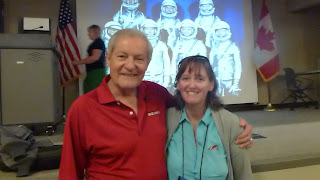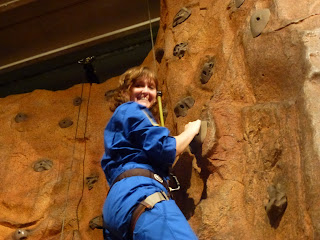As expected today was a little more
subdued than the previous days, with people being a little quieter knowing that
this was to be our last full day.
Placed into groups we were given a whole
host of materials to make a parachute for a weighted pyramid. As our previous
egg-stranaut did not make it, we were determined to make a safe trip. The
activity was being marked on how long it took for the pyramid to land and the
weight had to be under 100gs. We came in second. It was a great design and
aptly named the lemon jelly, as it resembled a jelly fish, but some else just
beat us, using a larger parachute!
Our second activity of the day was to put
us in the place of scientists who were helping to create a safe community in
space. Sadly the water has been contaminated! So we were given lots of
different materials with the task of ensuring that there was clean water to
drink. We were given very green water, filled with hair and other bits of
nasty’s! We thought we had a great idea, but it was not going as well as we
hoped, so we modified it. This really did not work out as planned! The water
rose in connectivity and greatly lowered in it's PH levels. Not to mention that
it came out grey. We were a long way of winning this one!
We then listened to a talk, about
industry-leading technology to support production design, engineering and STEM
education. This was more aimed at High School students but could be used for
upper primary activities, especially useful to encourage students into
engineering. The free software basically turned a 2D drawing into an
interactive 3D model, allowing students to clearly see their designs.
Dan Oates then provided us with some
insight to some of the special programs that Space Camp delivers to ALL
children. Dan ensures that the SPACE CAMP and AVIATION CHALLENGE programs
are specifically designed for special needs students, including camps for
blind, and/or visually-impaired, deaf and/or hard-of-hearing, and a week at the
end of summer designated for special needs youth. He had lots of stories to share
about his voluntary experiences over the past 20 years working with these
special needs students. Most of these children have hurdles to face every day,
but the hurdles they face at Space Camp ensure that their self-confidence and
self-ability levels go through the roof. When a blind child is about to jump
off the edge of the high wall, he just jumps - no fear, as he cannot see how
high he is. This gives him an advantage to those students who can see exactly
how high it is. It is not often that they children have the advantage over the
other children. Space Camp ensures that modifications are made to include all
children. This was very inspirational, demonstrating how inclusion should be
work.
In connection with the first activity of
the day, our task was to drop a Lunar Rover onto Mars. This meant that we had
to design a safe container that would drop from a first floor level without
killing the egg-stranaut inside. Our design was quick and cheap. We dropped our
Lander into the hoop, but it bounced slightly out - 8 points were deducted as
it landed 8cm away from the hoop/crater. Then we released the Rover down the
ramp with the egg-stranaut safe inside. You scored points on the distance the
Rover traveled. Our Rover went the further! Then we had to check that the
Egg-stranaut was unharmed, with not even a crack - we scored the highest points
and finally won our first activity challenge! Whoo too!
Our final activity - was to make a robotic
arm in case our space shuttle required repairs. Using the materials provided we
made an arm out of card that could move in both directions by pulling on the
strings. Our design worked brilliantly and successfully completed the task.
It was now time to Graduate. We each
received our wings and our upside down name badge was taken off and placed the
correct way up. It was at this point, on behalf of all the Aussies and the
other Educators I took the opportunity in thanking Space Camp for their
wonderful hospitality and most importantly for all the experiences that they had
provided. Our Team Leader had often said that, "Once at Space Camp nothing
will be the same again". She is not wrong. Jennifer provided us with the
enthusiasm to keep on going, no matter how tired we were. I am proud to say
that I have learnt so much...and I am eager to share these experiences.
 |
| Our finished parachute - the Lemon jelly! With Team Mates - Jessica, Jacqueline and Mark. |
 |
| Explaining how our Water Filter was not a good system. Thank you Ryan for your wonderful explanation. |
 |
| With my new American Buddy - Jacqueline. |
 |
| Mark, Corie, Jacqueline, Jennifer, Vicky, Me, Jessica and Ryan. What a team we made! This was part of Team Columbus! |
| In my spacesuit weightless - it was not easy at all! |
| Completing this task was a lot harder than you think! |
| The view from the screen of the cockpit of the Orion Shuttle simulator. My role was that of Mission Specialist, hitching a ride with Rastus before our moon walk! Mallisa was Commander who landed the shuttle safely, and Ryan was the pilot. |
 |
| Making the parachute with team mates Jess and Mark, Whilst Jacqueline kindly took the photo! |
Our Team designed this badge. Each badge tells a story.
Can you see some of the things that our group thought
was important to include as part of our story?
List the items that you can see, and explain why you think they were included.













